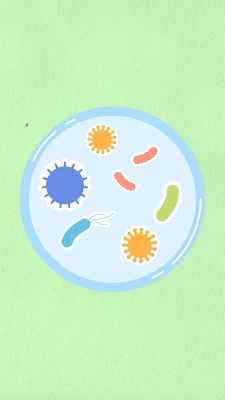Microrganisms : Friend and Foe (Class - 8) NCERT Science Sollution
Class
– 8
Subject
– Science
Chapter
– 2 : Microorganisms : Friends and Foe
Exercise (Question and Answer)
Question 1. Fill in the
blanks.
(a)
Microorganisms can be seen with the help of a _microscope_.
(b) Blue
green algae fix _nitrogen_ directly from
air and enhance fertility of soil.
(c)
Alcohol is produced with the help of _yeast_.
(d)
Cholera is caused by _bacteria_.
Question 2. Tick the correct
answer.
(a)
Yeast is used in the production of
(i)
sugar
(ii) alcohol
(iii)
hydrochloric acid (iv) oxygen
Answer - (ii) Yeast
(b) The
following is an antibiotic
(i)
Sodium bicarbonate. (ii) Streptomycin (iii) Alcohol.
(iv)
Yeast
Answer - (ii)
Streptomycin
(c)
Carrier of malaria-causing protozoan is
(i)
female Anopheles mosquito (ii) cockroach
(iii)
housefly
(iv) butterfly
Answer - (i) female
Anopheles mosquito
(d) The
most common carrier of communicable diseases is
(i)
ant
(ii) housefly
(iii)
dragonfly
(iv) spider
Answer - (ii) housefly.
(e) The
bread or idli dough rises because of
(i)
heat.
(ii)
grinding
(iii)
growth of yeast cells. (iv) kneading
Answer - (iii) growth
of yeast
(f) The
process of conversion of sugar into alcohol is called
(i)
nitrogen fixation. (ii) moulding
(iii)
fermentation (iv)
infection
Answer - (iii)
fermentation
Question 3. Match the organisms
in Column A with their action in Column B.
Answer -
|
Column A |
Column B |
|
Bacteria |
Causing
Cholera |
|
Rhizobium |
Fixing
Nitrogen |
|
Lactobacillus |
Setting
of curd |
|
Yeast |
Baking
of bread |
|
A
protozoan |
Causing
Malaria |
|
A Virus |
Causing
AIDS |
Question 4. Can
microorganisms be seen with the naked eye? If not, how can they be
seen?
Answer - No , microorganisms can not be
seen with naked eyes. They can be seen with the help of microscope.
Question 5. What are the major
groups of microorganisms?
Answer - The major group of
microorganisms are as follows -
1.
Viruses
2.
Bacteria
3. Algea
4. Fungi
5.
Protozoa
Question 6. Name the
microorganisms which can fix atmospheric nitrogen in the soil.
Answer - The microorganism which can fix
atmospheric nitrogen in the soil is Cyanobacteria (blue green algae).
Question 7. Write 10 lines on the
usefulness of microorganisms in our lives.
Answer - (i) Micro-organisms are used in
the making of curd.
(ii) Microorganisms are used in the making of
bread and cake.
(iii) Micro-organisms are used in the production of
alcohol.
(iv) Microorgamisms are used in the synthesis of
acetic acid (vinegar).
(v) Micro-organisms are used in the preparation of
medicines (or drugs) called antibiotics.
(vi) Micro-organisms are used in agriculture to
increase the fertility of soil by fixing atmospheric nitrogen gas (to form
nitrogen compounds).
(vii) microorganisms are used in the manufacturing
of vaccine. ex- corona vaccine.
(viii) Micro-organisms clean up the environment by
decomposing the organic matter of dead plants, dead animals and animal wastes
into harmless and useful simple substances.
(ix) Some microorganisms like blue green algea
produce oxygen in the process of photosynthesis.
(x) Some Algae and Fungi are used as food.
Question 8. Write a short
paragraph on the harmful effects of microorganisms.
Answer - Micro-organisms can be harmful
in many ways. For example, some of the micro-organisms cause diseases in human
beings, other animals and plants. Those micro-organisms which cause diseases
are called pathogens. Thus, pathogens are disease-causing micro-organisms.
Pathogens can be bacteria, viruses, protozoa or fungi, etc. Micro-organisms
cause diseases such as tuberculosis (TB), tetanus, diphtheria, whooping cough,
cholera, typhoid, AIDS, food poisoning, malaria, smallpox and chickenpox, etc.
Some micro-organisms spoil food, clothing and leather objects.
Question 9. What are antibiotics?
What precautions must be taken while taking antibiotics?
Answer - A medicine which stops the
growth of, or kills the disease-causing micro-organisms is called an
antibiotic. The source of antibiotic medicines are micro-organisms.
Some of the precautions to be observed in the use of
antibiotics are as follows :
(i) Antibiotics should be taken only on the advice
of a qualified doctor.
(ii) A person must complete the ‘full course’ of
antibiotics prescribed by the doctor.
(iii) The antibiotics should be taken in proper
doses as advised by the doctor. If a person takes antibiotics in wrong doses
(or when not needed), it may make the antibiotics less effective when the
person might need it in future.
(iv) Antibiotics should not be taken unnecessarily.
Antibiotics taken unnecessarily may kill the useful bacteria in the body and
harm us.




Comments
Post a Comment